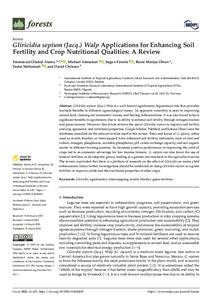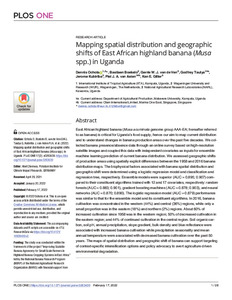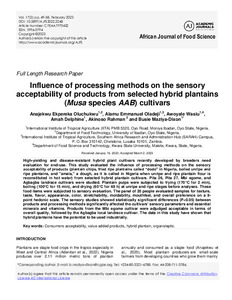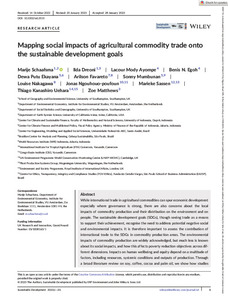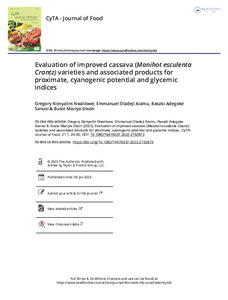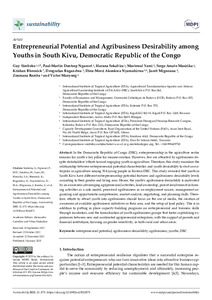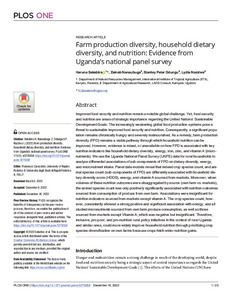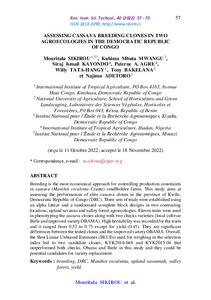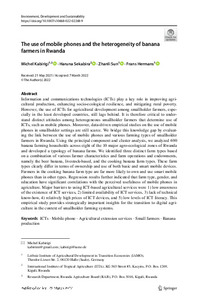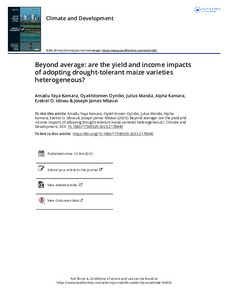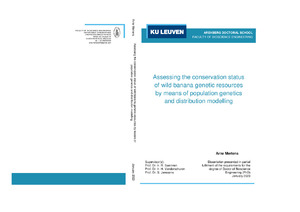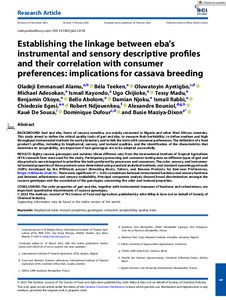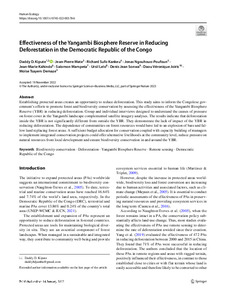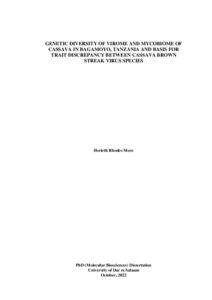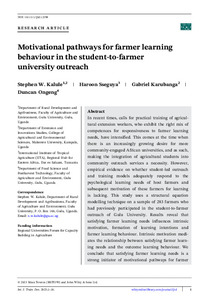Welcome to the International Institute of Tropical Agriculture Research Repository
Journal and Journal Articles: Recent submissions
Now showing items 281-300 of 5157
-
Gliricidia sepium (Jacq.) walp applications for enhancing soil fertility and crop nutritional qualities: a review
(2023-03-21)Gliricidia sepium (Jacq.) Walp is a well-known agroforestry leguminous tree that provides multiple benefits in different agroecological zones. Its apparent versatility is seen in improving animal feed, cleaning environmental wastes, and healing inflammations. It was also found to have significant benefits in agroforestry due to its ability to enhance soil fertility through nitrogen fixation and green manure. However, this article reviews the use of Gliricidia sepium to improve soil fertility and ... -
Mapping spatial distribution and geographic shifts of east African highland banana (Musa spp.) in Uganda
(2022-02-17)East African highland banana (Musa acuminata genome group AAA-EA; hereafter referred to as banana) is critical for Uganda’s food supply, hence our aim to map current distribution and to understand changes in banana production areas over the past five decades. We collected banana presence/absence data through an online survey based on high-resolution satellite images and coupled this data with independent covariates as inputs for ensemble machine learning prediction of current banana distribution. ... -
Influence of processing methods on the sensory acceptability of products from selected hybrid plantains (Musa species AAB) cultivars
(2023-02)High-yielding and disease-resistant hybrid plant cultivars recently developed by breeders need evaluation for end-use. This study evaluated the influence of processing methods on the sensory acceptability of products (plantain chips, fried ripe plantains called “dodo” in Nigeria, boiled unripe and ripe plantains, and "amala," a dough, as it is called in Nigeria when unripe and ripe plantain flour is reconstituted in hot water) from selected hybrid plantain cultivars. Pita 26, Pita 27, Mbi egome, ... -
Mapping social impacts of agricultural commodity trade onto the sustainable development goals
(2023-02-07)While international trade in agricultural commodities can spur economic development especially where governance is strong, there are also concerns about the local impacts of commodity production and their distribution on the environment and on people. The sustainable development goals (SDGs), though seeing trade as a means to support their achievement, recognise the need to address potential negative social and environmental impacts. It is therefore important to assess the contribution of international ... -
Impact of improved hermetic storage on food insecurity and poverty of smallholder cowpea farmers in northwestern Nigeria
(2023-12-07)Postharvest loss of cowpea grains due to insect pests like cowpea bruchids is a common problem in Nigeria and has often exacerbated the food insecurity and poverty of households. In a bid to protect their cowpea grains, farmers’ indiscriminate use of insecticides (often misused and overused) has had a negative impact on human health and the environment. Efforts to promote the use of non-chemical hermetic storage have sought to address the issue. This study, therefore, examined the impact of a ... -
Evaluation of improved cassava (Manihot esculenta Crantz) varieties and associated products for proximate, cyanogenic potential and glycemic indices
(2023-01-05)This study investigated the proximate, cyanide, and glycemic indices of roots and eba (gari dough) made from improved cassava cultivars. Twenty cassava cultivars were obtained from the IITA research farms and analyzed for proximate and carbohydrate compositions and cyanogenic potential using standard procedures. Afterward, four cassava varieties were selected using the agglomerate hierarchical cluster analysis. The selected varieties were processed into gari and reconstituted in hot water into ... -
Entrepreneurial potential and agribusiness desirability among youths in South Kivu, Democratic Republic of the Congo
(2023-01-03)In the Democratic Republic of Congo (DRC), entrepreneurship in the agriculture sector remains for youth a key pillar for income creation. However, few are attracted by agribusiness despite stakeholders’ efforts toward engaging youth in agriculture. Therefore, this study examines the relationship between entrepreneurial potential characteristics and youth desirability to start an enterprise in agriculture among 514 young people in Eastern DRC. This study revealed that youth in South Kivu have ... -
Farm production diversity, household dietary diversity, and nutrition: evidence from Uganda's national panel survey
(2022-12-16)Improved food security and nutrition remain a notable global challenge. Yet, food security and nutrition are areas of strategic importance regarding the United Nations’ Sustainable Development Goals. The increasingly weakening global food production systems pose a threat to sustainable improved food security and nutrition. Consequently, a significant population remains chronically hungry and severely malnourished. As a remedy, farm production diversity (FPD) remains a viable pathway through which ... -
Assessing cassava breeding clones in two agroecologies in the Democratic Republic of Congo
(2022-12)Breeding is the most economical approach for controlling production constraints in cassava (Manihot esculenta Crantz) smallholder farms. This study aims at assessing the performances of elite cassava clones in the province of Kwilu, Democratic Republic of Congo (DRC). Three sets of trials were established using an alpha lattice and a randomized complete block designs in two contrasting locations, upland savanna and valley forest agroecologies. Eleven traits were used in phenotyping the cassava ... -
Farmers’ preferences for east African highland cooking banana ’Matooke’ hybrids and local cultivars
(2023-03-08)Background An understanding of farmers' preferences of new banana cultivars and their characteristics is critical for developing and selecting cultivars that meet consumer needs. Therefore, phenotypic selection in a genetically variable population remains an important aspect of plant breeding. Methods The participatory varietal selection approach for preference ranking was used on 31 'Matooke' secondary and primary triploid hybrids and local banana cultivars evaluated between 2016 and 2019 in ... -
The use of mobile phones and the heterogeneity of banana farmers in Rwanda
(2022-03-29)Information and communications technologies (ICTs) play a key role in improving agricultural production, enhancing socio-ecological resilience, and mitigating rural poverty. However, the use of ICTs for agricultural development among smallholder farmers, especially in the least developed countries, still lags behind. It is therefore critical to understand distinct attitudes among heterogeneous smallholder farmers that determine use of ICTs, such as mobile phones. Moreover, data-driven empirical ... -
Circular bioeconomy in African food systems: what is the status quo? Insights from Rwanda, DRC, and Ethiopia
(2022-10-20)Increasing global food insecurity amidst a growing population and diminishing production resources renders the currently dominant linear production model insufficient to combat such challenges. Hence, a circular bioeconomy (CBE) model that ensures more conservative use of resources has become essential. Specifically, a CBE model that focuses on recycling and reusing organic waste is essential to close nutrient loops and establish more resilient rural-urban nexus food systems. However, the CBE ... -
Beyond average: are the yield and income impacts of adopting drought-tolerant maize varieties heterogeneous?
(2023-02-23)Assessing the benefits of adopting climate-resilient farming technologies without considering the heterogeneity among farmers, may not provide a sufficient evidence base for policy. Yet, most empirical studies do not go beyond documenting the average effects of climate-resilient technologies. Using farm household survey data from Nigeria, this paper examines whether and to what extent the yield and income impacts of adopting drought-tolerant maize varieties are heterogeneous. We used the ... -
Assessing the conservation status of wild banana genetic resources by means of population genetics and distribution modelling
(Katholieke Universiteit Leuven, 2023-01)Crop wild relatives (CWR) are wild plant species that are closely related or ancestral to cultivated plants. Because they often have high allelic diversity compared to their associated crop, they are an important source for the improvement of multiple agronomic traits such as yield or the resistance against biotic or abiotic stresses. Loss of genetic diversity due to increasing anthropogenic pressure now threatens their long term survival. There is a growing recognition of the importance of CWR ... -
Establishing the linkage between Eba’s instrumental and sensory descriptive profiles and their correlation with consumer preferences: implications for cassava breeding
(2023-02-22)Background Gari and Eba (cassava semolina) is mainly consumed in Nigeria and other West African countries. Defining the food product profile (biophysical, sensory, and textural qualities) that drives its acceptability, and integrating the component traits into breeding programs, are critical for the better adoption of new genotypes. This study aimed to define the Gari and Eba critical quality traits, define medium and high throughput instrumental methods for use by breeders, measure their respective ... -
Assessment of structure and governance of amenity trees in the premises of International Institute of Tropical Agriculture (IITA), Ibadan, Nigeria
(University of Ibadan, 2021-10)Amenity trees are components of the urban forest which contribute significantly to human wellbeing and improves environmental quality. Benefits derivable from amenity trees are numerous but inadequate or lack of knowledge of the structure of the urban treescape as well as poor or no management practices like institutional framework has limited these benefits. A number of institutions has lot of trees planted within their premises. However, more often than not, those trees have become hazardous and ... -
Effect of shade on ecophysiology of cocoa under stress conditions
(University of Ghana, 2021-09)Climate models predict increasing air temperature and decreasing rainfall patterns among cocoa growing regions around the world. Both heat and drought stress are known to affect physiology of cocoa plants through reduced rates of photosynthesis, lack of water and generally impaired physiological processes. This in turn leads to decreased yields and in severe cases, increased risks of mortality. Many studies have reported positive effects of shade on cocoa production; however, interest of full sun ... -
Effectiveness of the Yangambi biosphere reserve in reducing deforestation in the Democratic Republic of the Congo
(2023-01)Establishing protected areas creates an opportunity to reduce deforestation. This study aims to inform the Congolese government’s efforts to promote forest and biodiversity conservation by assessing the effectiveness of the Yangambi Biosphere Reserve (YBR) in reducing deforestation. Group and individual interviews designed to understand the causes of pressure on forest cover in the Yangambi landscape complemented satellite imagery analyses. The results indicate that deforestation inside the YBR ... -
Genetic diversity of virome and mycobiome of cassava in Bagamoyo, Tanzania and basis for treat discrepancy between cassava brown streak virus species
(University of Dar es Salaam, 2022-10)Brown streak is the most destructive viral disease of cassava causing up to 100% yield loss whilst fungal diseases contribute up to 90% cassava yield loss in Sub Saharan Africa. Genetic diversity of novel virus and fungal species infecting cassava in Bagamoyo, Tanzania is not fully comprehended. For unclear reasons, it is difficulty to breed resistance for one causal pathogen of cassava brown streak disease (CBSD), Cassava Brown Streak Virus (CBSV) compared to another, Ugandan Cassava Brown Streak ... -
Motivational pathways for farmer learning behaviour in the student‐to‐farmer university outreach
(2023-02-23)In recent times, calls for practical training of agricultural extension workers, who exhibit the right mix of competences for responsiveness to farmer learning needs, have intensified. This comes at the time when there is an increasingly growing desire for more community‐engaged African universities, and as such, making the integration of agricultural students into community outreach services a necessity. However, empirical evidence on whether student‐led outreach and training models adequately ...

